Role of the Wall Layer in 3D-Printed Composites under the Salt Spray Condition
Abstract
1. Introduction
2. Experiments
2.1. Specimen Preparation
2.2. Salt Spray Test
2.3. Tensile Test
3. Results
3.1. Saltwater Absorption Rate
3.2. Tensile Properties
3.2.1. Tensile Strength
3.2.2. Relationship between the Saltwater Absorption Rate and Tensile Strength
3.3. Failure Mode
4. Conclusions
- Type 1 specimens showed a smaller increase in the saltwater absorption rate than the type 2 specimens. The difference in saltwater absorption rates was negligible at 15 days of exposure but was substantial at 30 days of exposure.
- For a given specimen type, the tensile strength decreased as the duration of saltwater exposure increased. The decrease in tensile strength was less for the type 1 specimens than for the type 2 specimens.
- A faster saltwater absorption rate resulted in more degradation of tensile strength. The tensile strength degradation was less for specimens with 15 days of saltwater exposure than for those with 30 days of saltwater exposure.
- The type 1 specimens mainly demonstrated A and L failure types regardless of the duration of saltwater exposure. Pristine type 2 specimens before any saltwater exposure also demonstrated the L failure type. However, saltwater exposure to type 2 specimens changed their failure type to D.
Author Contributions
Funding
Acknowledgments
Conflicts of Interest
References
- Nachtane, M.; Tarfaoui, M.; Abichou, M.A.; Vetcher, A.; Rouway, M.; Aâmir, A.; Mouadili, H.; Laaouidi, H.; Naanani, H. An overview of the recent advances in composite materials and artificial intelligence for hydrogen storage vessels design. J. Compos. Sci. 2023, 7, 119. [Google Scholar] [CrossRef]
- Pastuszak, P.D.; Muc, A. Application of composite materials in modern constructions. Key Eng. Mater. 2013, 542, 119–129. [Google Scholar] [CrossRef]
- Kim, D.U.; Seo, H.S.; Jang, H.Y. Study on mechanical bearing strength and failure modes of composite materials for marine structures. J. Mar. Sci. Eng. 2021, 9, 726. [Google Scholar] [CrossRef]
- Murdy, P.; Dolson, J.; Miller, D.; Hughes, S.; Beach, R. Leveraging the advantages of additive manufacturing to produce advanced hybrid composite structures for marine energy systems. Appl. Sci. 2021, 11, 1336. [Google Scholar] [CrossRef]
- Ford, S.; Despeisse, M. Additive manufacturing and sustainability: An exploratory study of the advantages and challenges. J. Clean. Prod. 2016, 137, 1573–1587. [Google Scholar] [CrossRef]
- Perry, A. 3D-printed apparel and 3D-printer: Exploring advantages, concerns, and purchases. Int. J. Fash Technol. Educ. 2018, 11, 95–103. [Google Scholar] [CrossRef]
- Li, H.; Liu, B.; Ge, L.; Chen, Y.; Zheng, H.; Fang, D. Mechanical performances of continuous carbon fiber reinforced PLA composites printed in vacuum. Compos. B Eng. 2021, 225, 109277. [Google Scholar] [CrossRef]
- Saeed, K.; McIlhagger, A.; Harkin-Jones, E.; Kelly, J.; Archer, E. Predication of the in-plane mechanical properties of continuous carbon fibre reinforced 3D printed polymer composites using classical laminated-plate theory. Compos. Struct. 2021, 259, 113226. [Google Scholar] [CrossRef]
- Hetrick, D.R.; Sanei, S.H.R.; Bakis, C.E.; Ashour, O. Evaluating the effect of variable fiber content on mechanical properties of additively manufactured continuous carbon fiber composites. J. Reinf. Plast. Compos. 2020, 40, 365–377. [Google Scholar] [CrossRef]
- Uşun, A.; Gümrük, R. The mechanical performance of the 3D printed composites produced with continuous carbon fiber reinforced filaments obtained via melt impregnation. Addit. Manuf. 2021, 46, 102112. [Google Scholar] [CrossRef]
- Saeed, K.; McIlhagger, A.; Harkin-Jones, E.; McGarrigle, C.; Dixon, D.; Ali Shar, M.; McMillan, A.; Archer, E. Characterization of continuous carbon fibre reinforced 3D printed polymer composites with varying fibre volume fractions. Compos. Struct. 2022, 282, 115033. [Google Scholar] [CrossRef]
- Al Rashid, A.A.; Ikram, H.; Koç, M. Additive manufacturing and mechanical performance of carbon fiber reinforced Polyamide-6 composites. Mater. Today Proc. 2022, 62, 6359–6363. [Google Scholar] [CrossRef]
- Froes, F. Combining additive manufacturing with conventional casting and reduced density materials to greatly reduce the weight of airplane components such as passenger seat frames. In Additive Manufacturing for the Aerospace Industry, 1st ed.; Froes, F., Boyer, R., Eds.; Elsevier Inc.: Amsterdam, The Netherlands, 2019; pp. 419–425. [Google Scholar] [CrossRef]
- Sangiuliano, L.; Reff, B.; Palandri, J.; Wolf-Monheim, F.; Pluymers, B.; Deckers, E.; Desmet, W.; Claeys, C. Low frequency tyre noise mitigation in a vehicle using metal 3D printed resonant metamaterials. Mech. Syst. Signal Process. 2022, 179, 109335. [Google Scholar] [CrossRef]
- Muralidharan, N.; Pratheep, V.G.; Shanmugam, A.; Hariram, A.; Dinesh, P.; Visnu, B. Structural analysis of mini drone developed using 3D printing technique. Mater. Today Proc. 2021, 46, 8748–8752. [Google Scholar] [CrossRef]
- Chen, L.; Zhang, Y.; Chen, Z.; Xu, J.; Wu, J. Topology optimization in lightweight design of a 3D-printed flapping-wing micro aerial vehicle. Chin. J. Aeronaut. 2020, 33, 3206–3219. [Google Scholar] [CrossRef]
- Jeong, D.G.; Seo, H.S. Study on mechanical performance of 3D printed composite material with topology shape using finite element method. Funct. Compos. Struct. 2021, 3, 035003. [Google Scholar] [CrossRef]
- Kalsoom, U.; Nesterenko, P.N.; Paull, B. Recent developments in 3D printable composite materials. RSC Adv. 2016, 6, 60355–60371. [Google Scholar] [CrossRef]
- Yang, B.; Zhang, J.; Zhou, L.; Lu, M.; Liang, W.; Wang, Z. Effect of fiber surface modification on water absorption and hydrothermal aging behaviors of GF/pCBT composites. Compos. B Eng. 2015, 82, 84–91. [Google Scholar] [CrossRef]
- Ronagh, H.; Saeed, N. Changes in mechanical properties of GFRP composite after exposure to warm seawater. J. Compos. Mater. 2016, 51, 2733–2742. [Google Scholar] [CrossRef]
- Wei, B.; Cao, H.; Song, S. Degradation of basalt fibre and glass fibre/epoxy resin composites in seawater. Corros. Sci. 2011, 53, 426–431. [Google Scholar] [CrossRef]
- Ding, A.; Wang, J.; Ni, A.; Li, S. Assessment on the ageing of sandwich composites with vinylester-based composite faces and PVC foam core in various harsh environments. Compos. Struct. 2019, 213, 71–81. [Google Scholar] [CrossRef]
- Batista, N.L.; Rezende, M.C.; Botelho, E.C. The influence of crystallinity on the weather resistance of CF/PEEK composites. Appl. Compos. Mater. 2021, 28, 235–246. [Google Scholar] [CrossRef]
- Fiore, V.; Scalici, T.; Calabrese, L.; Valenza, A.; Proverbio, E. Effect of external basalt layers on durability behaviour of flax reinforced composites. Compos. B Eng. 2016, 84, 258–265. [Google Scholar] [CrossRef]
- Yan, L.; Chouw, N. Effect of water, seawater and alkaline solution ageing on mechanical properties of flax fabric/epoxy composites used for civil engineering applications. Constr. Build. Mater. 2015, 99, 118–127. [Google Scholar] [CrossRef]
- Markforged. Available online: https://markforged.com/ (accessed on 18 June 2023).
- Praveen, B.M.; Venkatesha, T.V. Generation and corrosion behavior of Zn-nanosized carbon black composite coating. Int. J. Electrochem. Sci. 2009, 4, 258–266. [Google Scholar] [CrossRef]
- Wang, H.; Zhu, S.; Yao, H.; Di, Y.; Shu, M.; Li, J.; Zhang, B.; Cao, G.; Guan, S. Positive effect of the addition of polyaniline on the anticorrosive property of polyethersulfone two-layer composite coating. J. Appl. Polym. Sci. 2021, 138, 50758. [Google Scholar] [CrossRef]
- Atta, A.M.; Al-Lohedan, H.A.; El-Saeed, A.M.; Al-Shafey, H.I.; Wahby, M.H. Epoxy embedded with TiO2 nanogel composites as promising self-healing organic coatings of steel. Prog. Org. Coat. 2017, 105, 291–302. [Google Scholar] [CrossRef]
- Bagherzadeh, M.R.; Mahdavi, F. Preparation of epoxy–clay nanocomposite and investigation on its anti-corrosive behavior in epoxy coating. Prog. Org. Coat. 2007, 60, 117–120. [Google Scholar] [CrossRef]
- Zhang, Z.; Zhao, N.; Qi, F.; Zhang, B.; Liao, B.; Ouyang, X. Reinforced superhydrophobic anti-corrosion epoxy resin coating by fluorine–silicon–carbide composites. Coatings 2020, 10, 1244. [Google Scholar] [CrossRef]
- Markforged Material Data Sheet 2022, 20 January 2022. Available online: https://markforged.com/materials/ (accessed on 18 June 2023).
- American Society for Testing and Materials. Standard Test Method for Tensile Properties of Polymer Matrix Composite Materials (ASTM D3039/D3039M-17); ASTM International: West Conshohocken, PA, USA, 2017. [Google Scholar]
- American Society for Testing and Materials. Standard Practice for Operating Salt Spray(Fog) Apparatus (ASTM B117-19); ASTM International: West Conshohocken, PA, USA, 2019. [Google Scholar]
- Fiore, V.; Scalici, T.; Calabrese, L.; Valenza, A.; Bella, G.L. Durability of Flax-Basalt hybrid composites for marine applications. In Proceedings of the 20th International Conference on Composite Materials, Copenhagen, Denmark, 19–24 July 2015. [Google Scholar]
- Korach, C.S.; Chiang, F.P. Characterization of carbon fiber-vinylester composites exposed to combined UV radiation and salt spray. In Proceedings of the 15th European conference on composite materials, Venice, Italy, 24–28 June 2012. [Google Scholar]
- American Society for Testing and Materials. Standard Test Method for Water Absorption of Plastics (ASTM D570-22); ASTM International: West Conshohocken, PA, USA, 2022. [Google Scholar]
- Fiore, V.; Calabrese, L.; Proverbio, E.; Passari, R.; Valenza, A. Salt spray fog ageing of hybrid composite/metal rivet joints for automotive applications. Compos. B Eng. 2017, 108, 65–74. [Google Scholar] [CrossRef]
- Mohammadizadeh, M.; Fidan, I. Tensile Performance of 3D-Printed Continuous Fiber-Reinforced Nylon Composites. J. Manuf. Mater. Process. 2021, 5, 68. [Google Scholar] [CrossRef]
- Kumar Mishra, P.; Jagadesh, T. Investigation into tensile behavior of 3D printed nylon-based low and high-volume fraction carbon fiber composite. Rapid Prototyp. J. 2023. ahead-of-print. [Google Scholar] [CrossRef]
- Gellert, E.P.; Turley, D.M. Seawater immersion ageing of glass-fibre reinforced polymer laminates for marine applications. Compos. Part A Appl. Sci. Manuf. 1999, 30, 1259–1265. [Google Scholar] [CrossRef]
- Muflikhun, M.A.; Fiedler, B. Failure prediction and surface characterization of GFRP laminates: A study of stepwise loading. Polymers 2022, 14, 4322. [Google Scholar] [CrossRef] [PubMed]
- Mahmud, J.; Hussain, A.K.; Rahimi, N.; Rahim, M.A. Failure analysis of composite laminate based on experiment-simulation integration. CREAM Curr. Res. 2013, 2, 7–22. [Google Scholar]
- Muflikhun, M.A.; Yokozeki, T. Systematic analysis of fractured specimens of composite laminates: Different perspectives between tensile, flexural, Mode I, and Mode II test. Int. J. Lightweight Mater. Manuf. 2023, 6, 329–343. [Google Scholar] [CrossRef]
- Wu, X.F.; Dzenis, Y.A. Experimental determination of probabilistic edge-delamination strength of a graphite–fiber/epoxy composite. Compos. Struct. 2005, 70, 100–108. [Google Scholar] [CrossRef]
- Behera, R.P.; Rawat, P.; Singh, K.K. Tensile behavior of three phased glass/epoxy laminate embedded with MWCNTs: An experimental approach. Mater. Today Proc. 2018, 5, 8176–8183. [Google Scholar] [CrossRef]




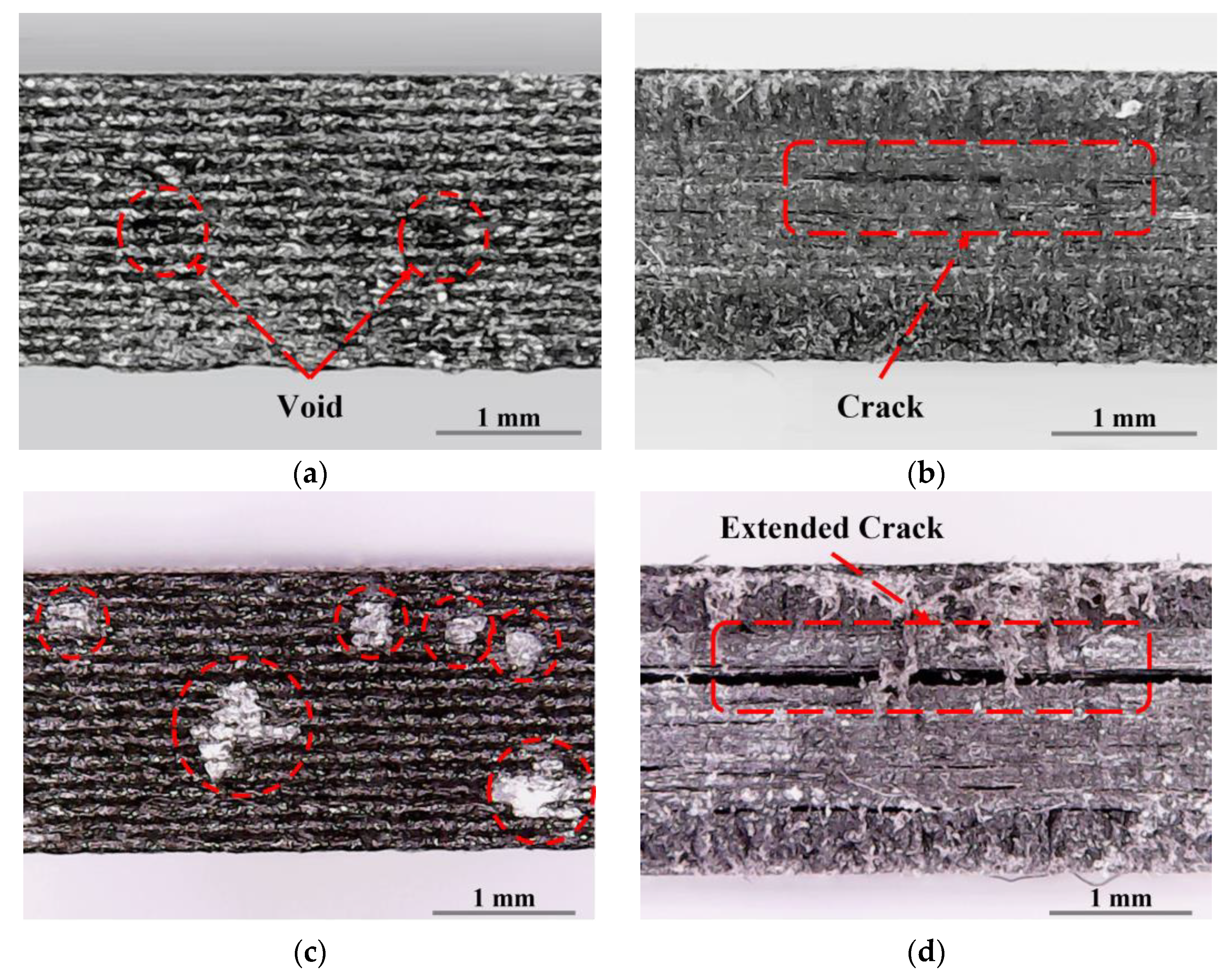
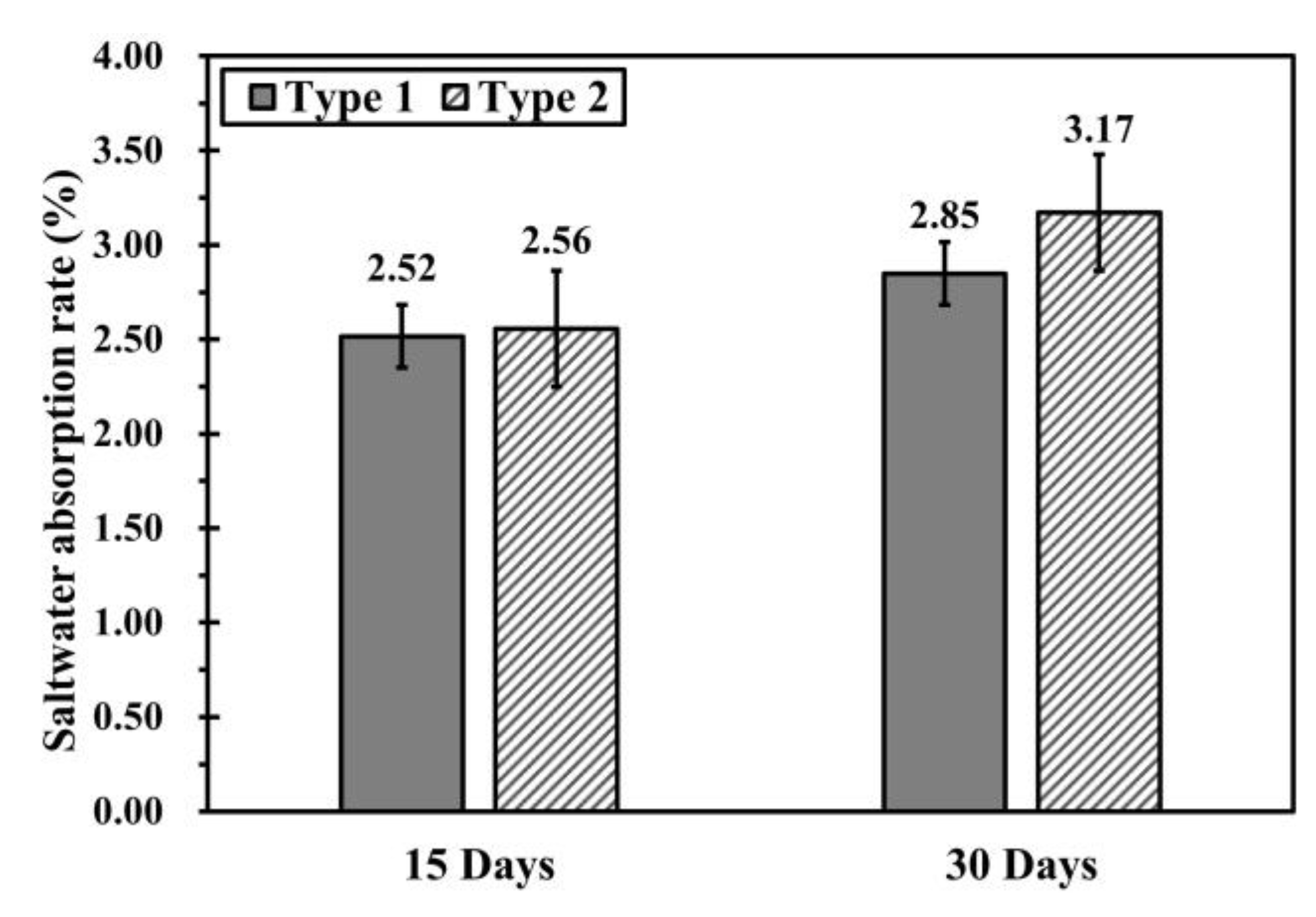
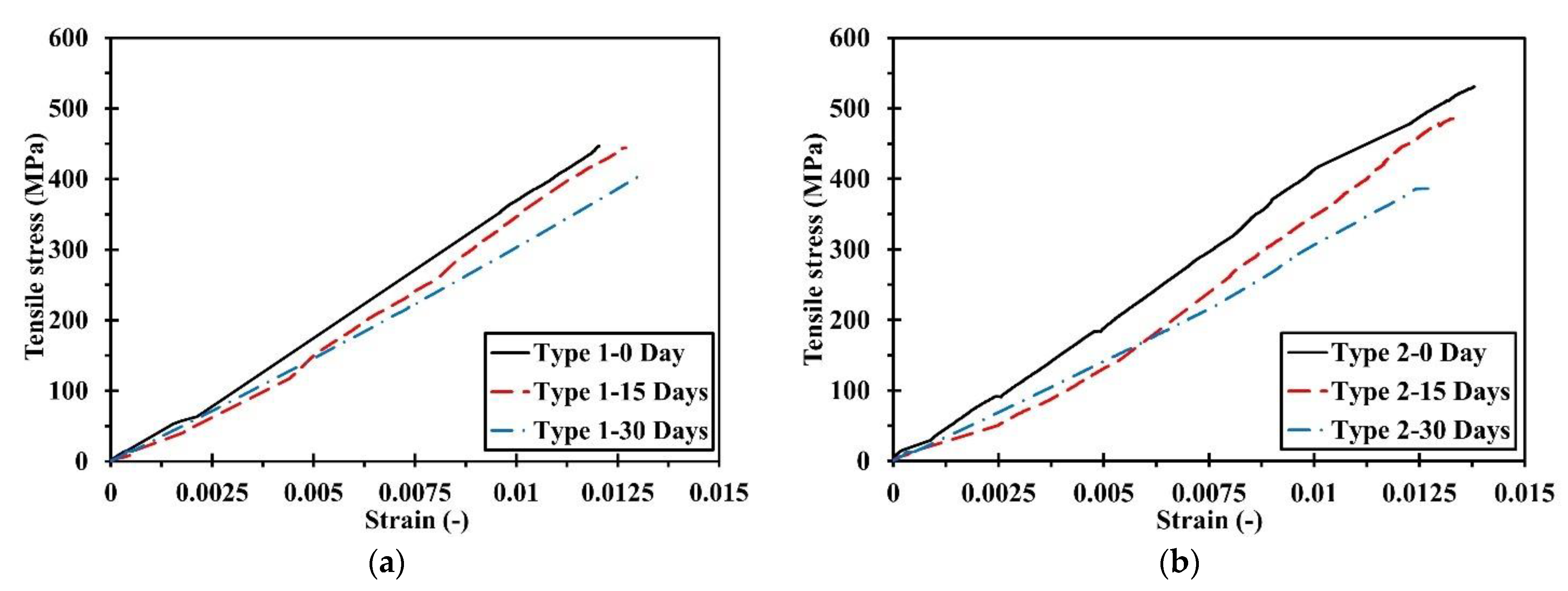

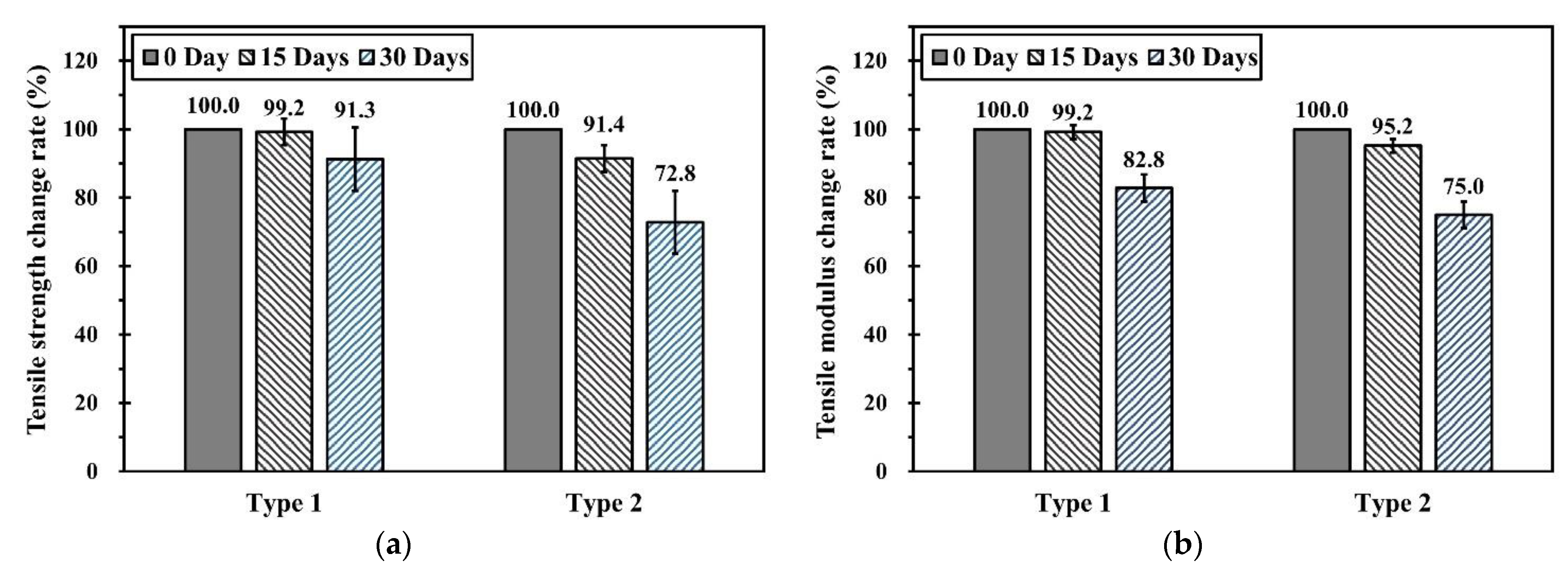
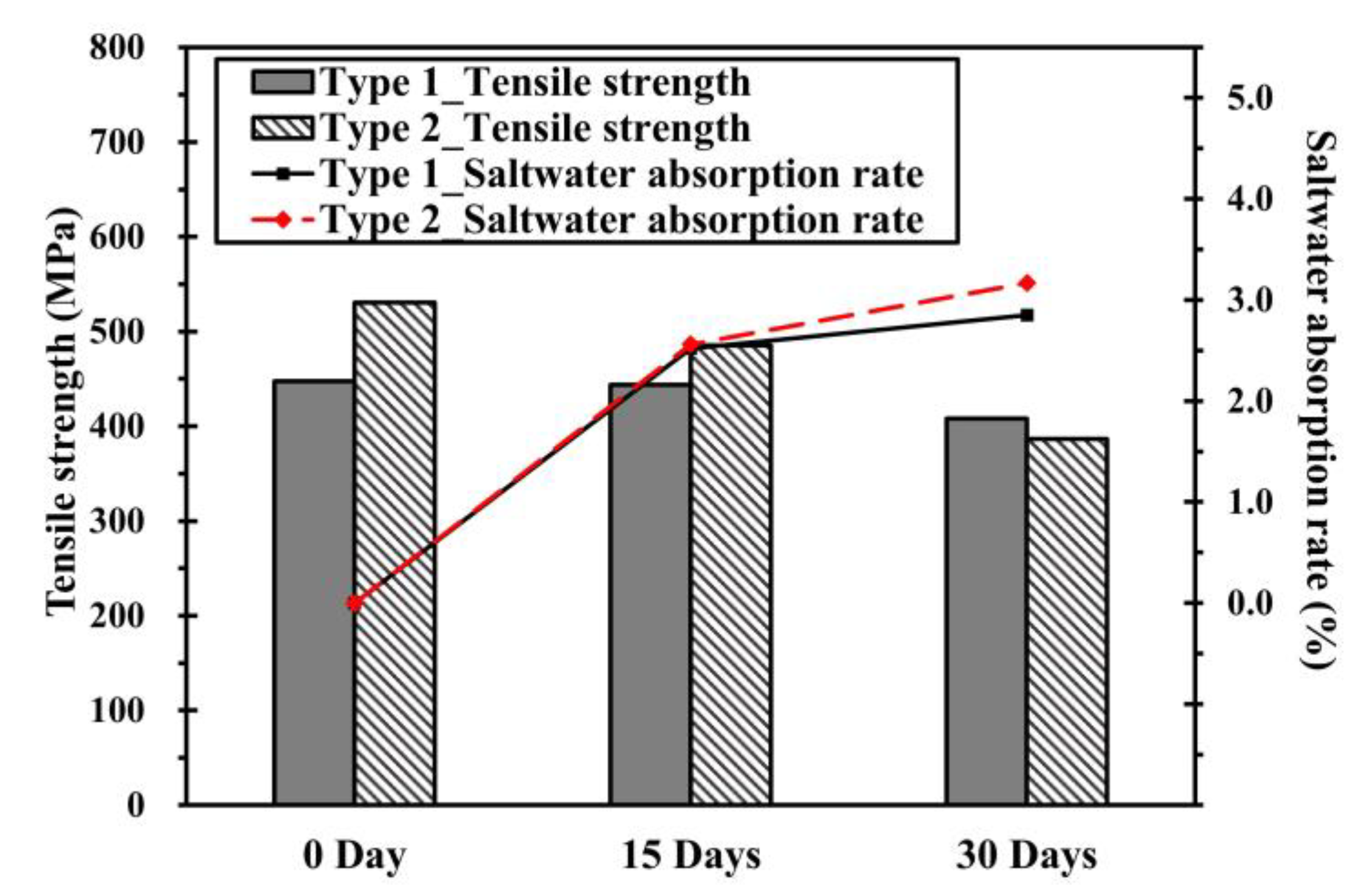
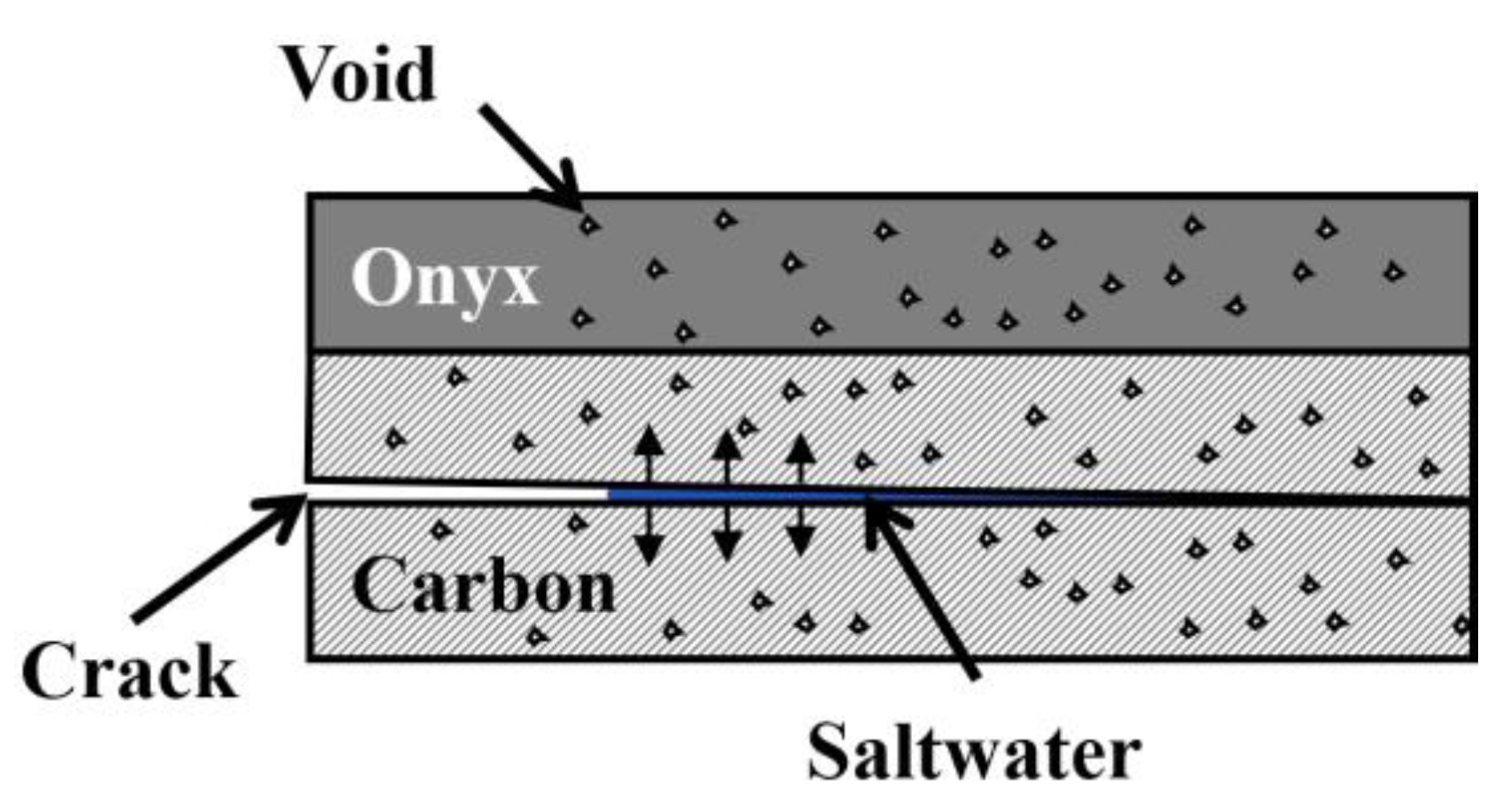

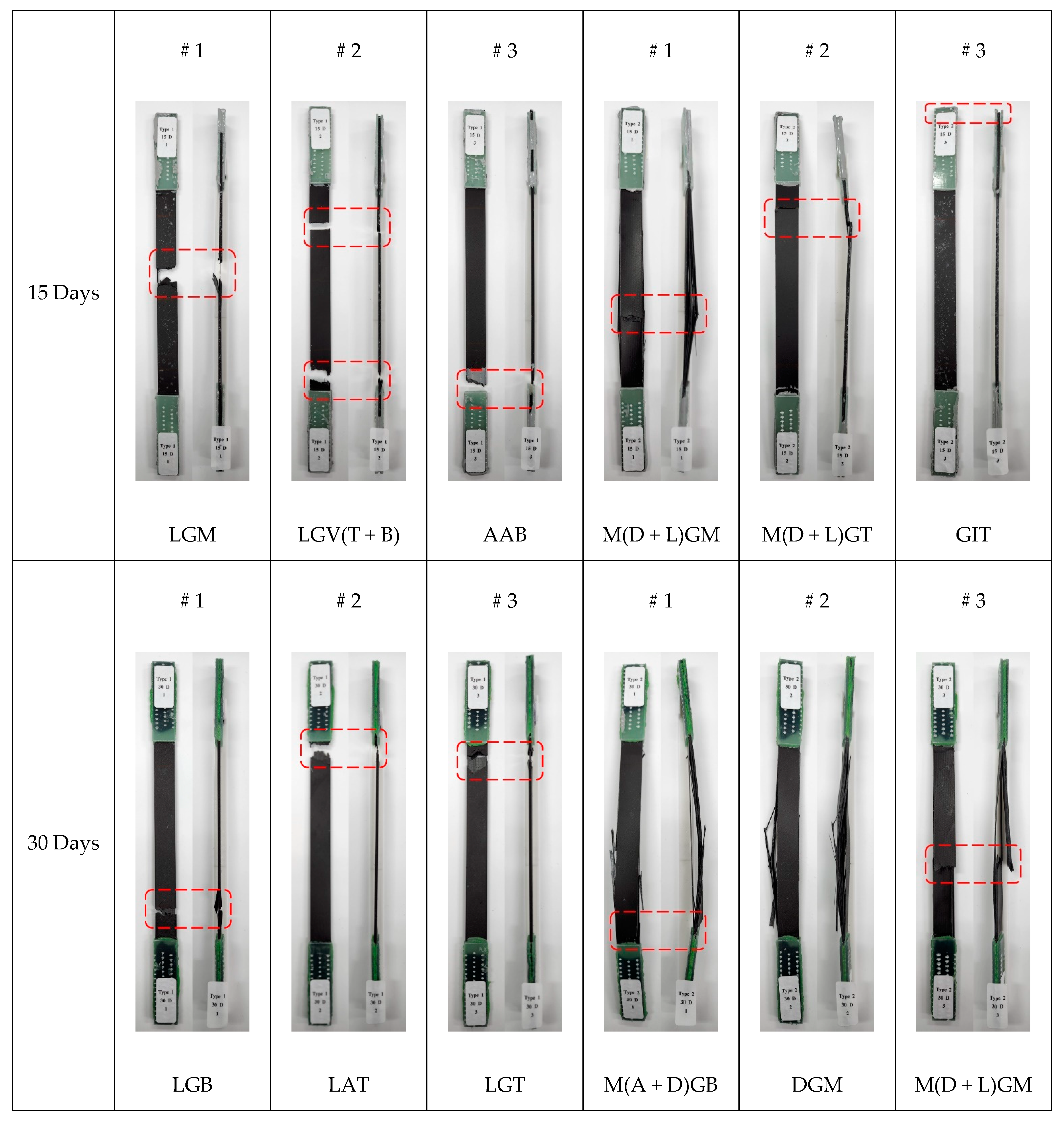
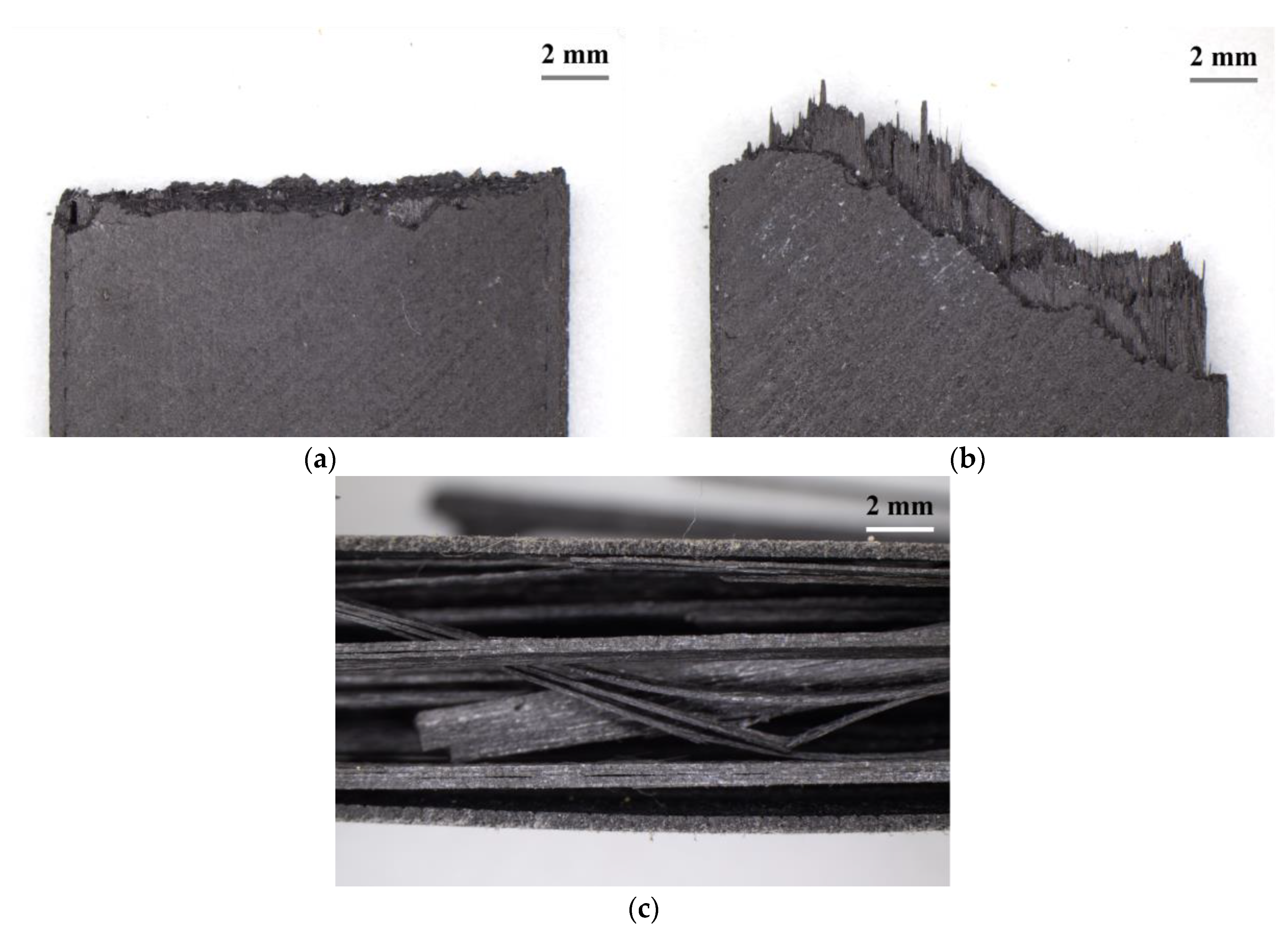
| Property | Carbon Fiber | Onyx |
|---|---|---|
| Tensile modulus (GPa) | 60 | 2.4 |
| Tensile strength (MPa) | 800 | 40 |
| Tensile strain (%) | 1.5 | 25 |
| Test (ASTM) | D 3039 | D 638 |
| Type | Material | Printing Direction | Total Layer NO. | Total Layer Thickness (mm) |
|---|---|---|---|---|
| Type 1 (With wall layer) | Onyx | [±45°]2 | 4 | 0.5 |
| Carbon fiber | [0°]8 | 8 | 1.0 | |
| Onyx | [±45°]2 | 4 | 0.5 | |
| Onyx(Wall layer) | - | 16 | 2.0 | |
| Type 2 (Without wall layer) | Onyx | [±45°]2 | 4 | 0.5 |
| Carbon fiber | [0°]8 | 8 | 1.0 | |
| Onyx | [±45°]2 | 4 | 0.5 |
| Concentration of Solution | Conditioned Temperature (°C) | Material | Critical Period (Days) | Ref. |
|---|---|---|---|---|
| Water | 25, 60 | GF/pCBT composite | 25 | [19] |
| Seawater | 60 | GFRP composite | 10 | [20] |
| Artificial seawater (6 wt.% salt) | 25 | BFRP, GFRP composite | 30 | [21] |
| 3.5% NaCl | 35 | Vinylester-based composite | 12.5 | [22] |
| 5% NaCl | 1, 10 | CF/PEEK composite | 25 | [23] |
| 35 | Flax–Basalt FRP composite | 25 | [24] | |
| 35 | Flax–Basalt FRP composite | 25 | [35] | |
| 35 | CF/Vinylester composite | 17 | [36] |
| Type | Exposure Period (Days) | Weight (g) | Weight Variation (g) | Saltwater Absorption Ratio (%) | |
|---|---|---|---|---|---|
| Before | After | ||||
| Type 1 (With wall layer) | 0 | 8.87 | 8.87 | 0 | 0 |
| 15 | 8.88 | 9.10 | 0.22 | 2.52 | |
| 30 | 8.89 | 9.15 | 0.25 | 2.85 | |
| Type 2 (Without wall layer) | 0 | 9.00 | 9.00 | 0 | 0 |
| 15 | 9.00 | 9.23 | 0.23 | 2.56 | |
| 30 | 9.04 | 9.33 | 0.29 | 3.17 | |
| Type | Exposure Period (Days) | Saltwater Absorption Ratio (%) | Tensile Modulus (GPa) | CV (%) | Tensile Strength (MPa) | CV (%) | Tensile Strain (-) | CV (%) |
|---|---|---|---|---|---|---|---|---|
| Type 1 | 0 | 0 | 37.05 | 1.48 | 447.48 | 1.42 | 0.0125 | 3.68 |
| 15 | 2.52 | 36.76 | 1.40 | 444.01 | 1.03 | 0.0127 | 0.86 | |
| 30 | 2.85 | 30.69 | 1.05 | 408.34 | 1.87 | 0.0132 | 3.36 | |
| Type 2 | 0 | 0 | 39.94 | 6.68 | 530.77 | 8.26 | 0.0138 | 11.64 |
| 15 | 2.56 | 38.02 | 8.66 | 485.29 | 5.25 | 0.0133 | 3.99 | |
| 30 | 3.17 | 29.96 | 3.88 | 386.33 | 4.11 | 0.0127 | 0.04 |
| Type | Exposure Period (Days) | Tensile Strength (MPa) | Difference (%) | |
|---|---|---|---|---|
| All Specimens | Specimens without the Tab Failure | |||
| Type 1 | 0 | 447.48 | 451.96 | 1.00 |
| 15 | 444.01 | 449.51 | 1.24 | |
| 30 | 408.34 | 409.30 | 0.24 | |
| First Character | Second Character | Third Character | |||
|---|---|---|---|---|---|
| Failure Type | Code | Failure Area | Code | Failure Location | Code |
| Angled | A | Inside grip/tab | I | Bottom | B |
| edge Delamination | D | At grip/tab | A | Top | T |
| Grip/tab | G | Gage | G | Left | L |
| Lateral | L | Multiple areas | M | Right | R |
| Multimode | M | Various | V | Middle | M |
| Splitting | S | Unknown | U | Various | V |
| eXplosive | X | Unknown | U | ||
| Other | O | ||||
Disclaimer/Publisher’s Note: The statements, opinions and data contained in all publications are solely those of the individual author(s) and contributor(s) and not of MDPI and/or the editor(s). MDPI and/or the editor(s) disclaim responsibility for any injury to people or property resulting from any ideas, methods, instructions or products referred to in the content. |
© 2023 by the authors. Licensee MDPI, Basel, Switzerland. This article is an open access article distributed under the terms and conditions of the Creative Commons Attribution (CC BY) license (https://creativecommons.org/licenses/by/4.0/).
Share and Cite
Kim, D.-H.; Seo, H.-S. Role of the Wall Layer in 3D-Printed Composites under the Salt Spray Condition. J. Mar. Sci. Eng. 2023, 11, 1416. https://doi.org/10.3390/jmse11071416
Kim D-H, Seo H-S. Role of the Wall Layer in 3D-Printed Composites under the Salt Spray Condition. Journal of Marine Science and Engineering. 2023; 11(7):1416. https://doi.org/10.3390/jmse11071416
Chicago/Turabian StyleKim, Do-Hyeon, and Hyoung-Seock Seo. 2023. "Role of the Wall Layer in 3D-Printed Composites under the Salt Spray Condition" Journal of Marine Science and Engineering 11, no. 7: 1416. https://doi.org/10.3390/jmse11071416
APA StyleKim, D.-H., & Seo, H.-S. (2023). Role of the Wall Layer in 3D-Printed Composites under the Salt Spray Condition. Journal of Marine Science and Engineering, 11(7), 1416. https://doi.org/10.3390/jmse11071416






